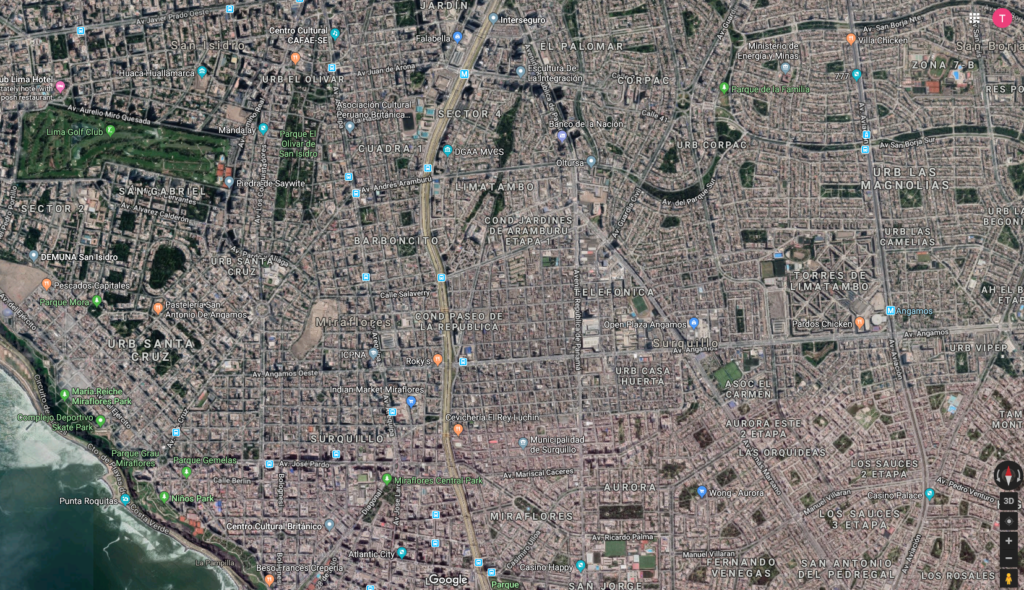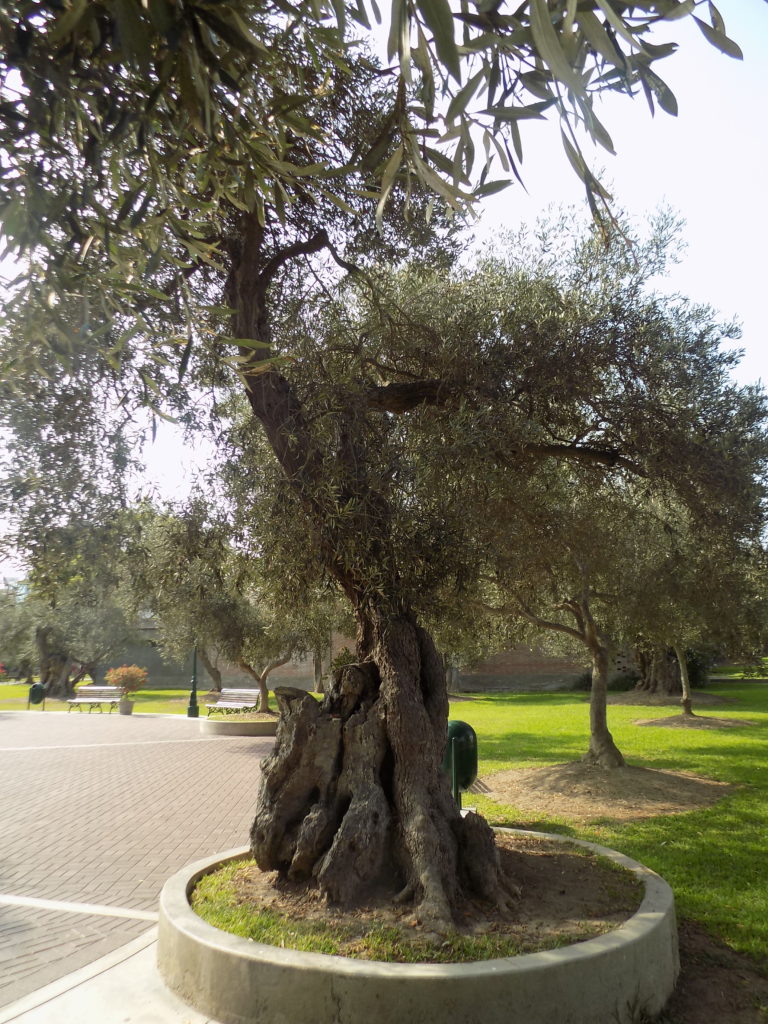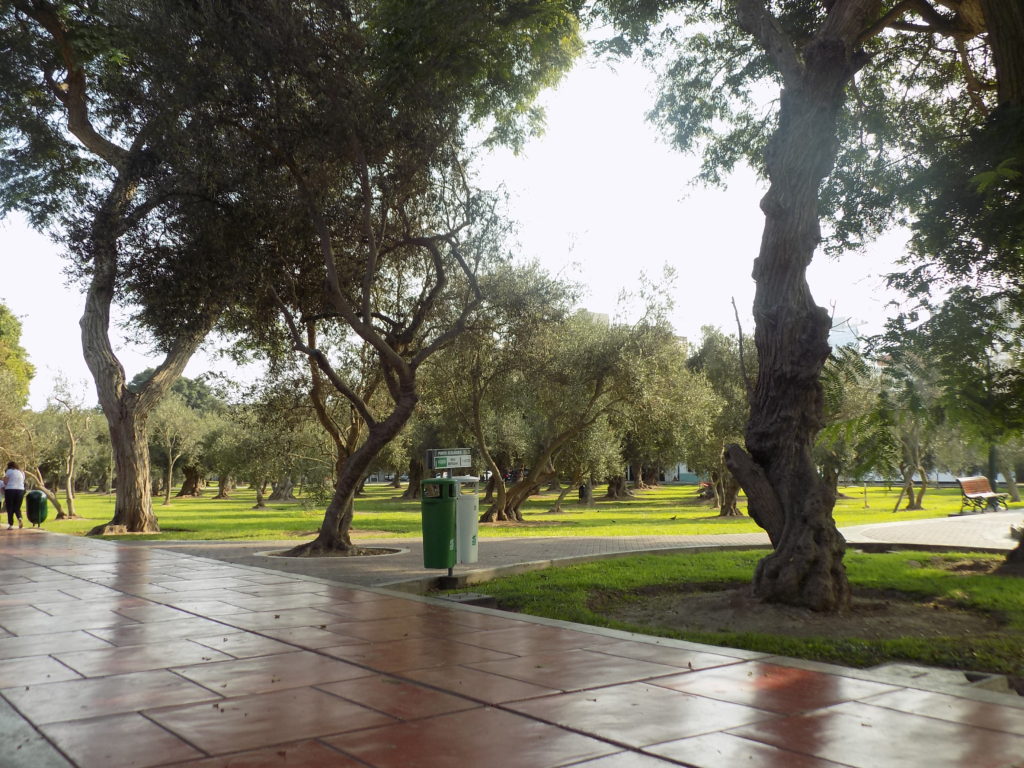This time it’s Roky’s
It was late in the afternoon and I was more than ready for lunch so I asked the museum guide if she might know of a nearby restaurant where I could have pollo a la brasa and she directed me to Roky’s about a kilometer away along Avenida Angamos. I hungrily set off in that direction.
The Roky’s on Av. Angamos didn’t have the look of a traditional polleria. In fact, had I not glanced across the street
I might well have walked past it. (I shot this photo later in the day while walking back to the hotel.) The street level is more of a full-service restaurant and the chicken is served upstairs but none of the rotisseries were in the open as we had seen at Norky’s and as is typical in the local pollerias I frequent. The meal offering was similar to Norky’s – a quarter chicken, French fries, and salad with an Inca Kola – for a slightly lower price. The salad came from a self-serve cart with too many sadly wilted vegetables.
The fries weren’t crispy and both the fries and the chicken were a bit too salty for my palate. Roky’s offered two salsas – an aji amarillo (yellow pepper sauce) that was considerably spicier than Maryland style yellow sauces but milder than the aji at Norky’s and a salsa roja (red sauce) that blasted my mouth with more heat than the amarillo and either of the sauces at Norky’s by several measures of Scoville scale magnitude. On the ride to the airport Alejandro told me that chimichurri is available at Roky’s but only on request. He also told me that Roky’s is a national chain and is the largest home grown restaurant in Perú. (Roky’s might be a national chain but for me the clear choice is Norky’s for its tasty chimichurri, somewhat crispier fries, and less salty chicken.)
Intriguing olives and the mustard cure
I always hope that every trip I take, no matter how well planned, will include moments of discovery and serendipity. I believe if I stay open to the possibilities, I’m bound to find surprises everywhere. The Parque El Olivar in Lima’s San Isidro section is that sort of place. It’s unexpected mainly because of its location even if my visit wasn’t serendipitous. I’d read about it on Atlas Obscura in the months leading up to the trip and since time wasn’t pressing, I knew I’d make the 2.5 kilometer walk from Roky’s.
(What wasn’t in my plans were the cramps in my right calf that nearly ground my walk to a halt about halfway to the park. Fortunately, I’d anticipated the possibility and had stashed several packets of mustard in one of the endlessly useful pockets of my travel vest. Yes, mustard. I’ve read claims that taking a teaspoon of mustard before bed prevents nighttime leg cramps. I’ve never used it prophylactically but at home I sleep with a squeeze bottle within reach because I have found it an effective cure. When I travel, I carry small packets in my vest and place one or two beside me wherever I sleep. Once again, this unconventional remedy worked like a charm and I was soon striding along with minimal and continually dissipating discomfort.)
For me, walking into a park populated with more than 1,650 olive trees from a surrounding environment that looks so decidedly urban qualifies as surprising.
(Satellite image screen capture from Google Maps)
(You can easily see the park if you enlarge the photo. It’s in the north just to the east of the golf course. If you enlarge the map, you’ll also see Central Park well to the south and just a bit east of the Olive Park.)
The park started with the only three trees that managed to survive the journey from Seville to Lima accompanying Antonio de Rivera in 1560. The land on which he planted them passed through many owners and until 1777 when it was acquired by Isidoro de Cortazar y Abarca, the first Count of San Isidro. By the time the count acquired the property, the three trees had become more than 3,000. Sadly, that would not long remain the case.
Spanish troops abandoned Lima sometime after 28 July 1821 when General José de San Martín declared Perú’s independence. On their way out of town, they chopped down thousands of the olive trees and mangled many others. Some still bear those scars today.
Financial difficulties forced both the Count and several subsequent owners to sell the property and it was eventually subdivided into 41 separate lots surrounding the larger park in the 1920s. As the new owners began building houses on these lots, however, they integrated the existing trees into the front and back yards of their property.
Today, the park is once again home to more than 3,000 trees but, rather than supporting solely olive trees, the number is spread over 44 species. There are also between 20 and 30 species of birds and, more importantly,
turtles!
I spotted the turtles in the man-made lagoon near a cultural center that I didn’t visit choosing instead to sit in a shady spot on one of the park’s many wooden benches and enjoy the serene ambiance that was disturbed only by the occasional rumble of a skateboard across the tiled paths.
Sitting quietly for more than an hour I let my thoughts retreat across the continent to Rio de Janeiro and its Atlantic beaches then drift slowly westward through my ascent and descent in the Andes before alighting in my current location a mere two kilometers east of the Pacific. I thought of the places I visited. I thought of my fellow travelers and the people we’d met. I thought of how visiting these places, adding knowledge from and of them, and listening with an attentive ear to people’s descriptions of their lives and their perceptions of the world have enriched me and my life. I thought of the companionship I shared along the way with my fellow travelers and I thought of the joy and pleasure they brought to my life.
And I hope, after reading this journal, you feel I have shared at least some of that with you.




